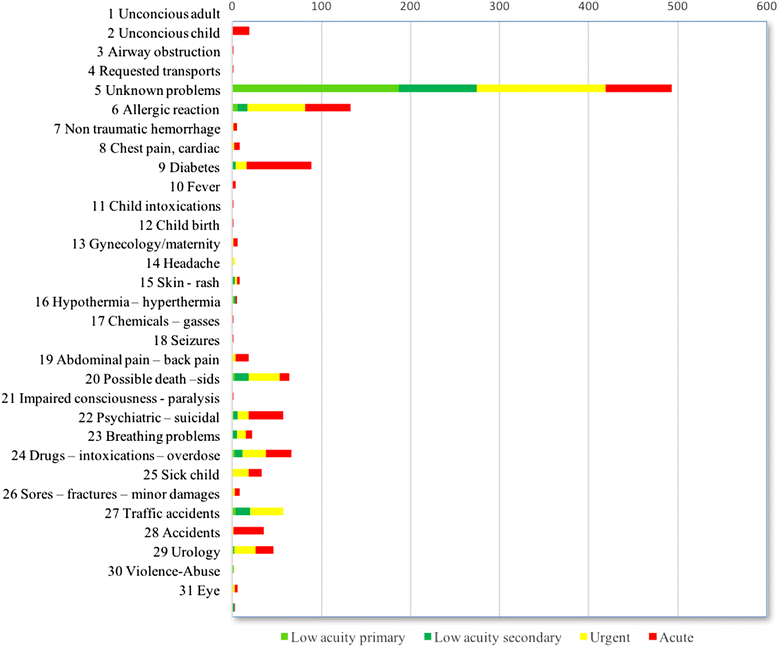Does the Norwegian emergency medical dispatch classification as non-urgent predict no need for pre-hospital medical treatment? An observational study
- PMID: 27154472
- PMCID: PMC4859986
- DOI: 10.1186/s13049-016-0258-8
Does the Norwegian emergency medical dispatch classification as non-urgent predict no need for pre-hospital medical treatment? An observational study
Abstract
Background: The number of ambulance call-outs in Norway is increasing owing to societal changes and increased demand from the public. Together with improved but more expensive education of ambulance staff, this leads to increased costs and staffing shortages. We wanted to study whether the current dispatch triage tools could reliably identify patients who only required transport, and not pre-hospital medical care. This could allow selection of such patients for designated transport units, freeing up highly trained ambulance staff to attend patients in greater need.
Methods: A cross-sectional observational study was used, drawing on all electronic and paper records in our ambulance service from four random days in 2012. The patients were classified into acuity groups, based on Emergency Medical Dispatch codes, and pre-hospital interventions were extracted from the Patient Report Forms.
Results: Of the 1489 ambulance call-outs included in this study, 82 PRFs (5 %) were missing. A highly significant association was found between acuity group and recorded pre-hospital intervention (p ≤ 0.001). We found no correlation between gender, distance to hospital, age and pre-hospital interventions. Ambulances staffed by paramedics performed more interventions (234/917, 26 %) than those with emergency medical technicians (42/282, 15 %). The strongest predictor for needing pre-hospital interventions was found to be the emergency medical dispatch acuity descriptor.
Discussion: This study has demonstrated that the Norwegian dispatch system is able to correctly identify patients who do not need pre-hospital interventions. Patients with a low acuity code had a very low level of pre-hospital interventions. Evaluation of adherence to protocol in the Emergency Medical Dispatch is not possible due to the inherent need for medical experience in the triage process.
Conclusions: This study validates the Norwegian dispatch tool (Norwegian index) as a predictor of patients who do not need pre-hospital interventions.
Keywords: Acuity level; Ambulance service; Emergency medical dispatch; Need predictor; Norway; Pre-hospital medical treatment.
Figures
Similar articles
-
Patient and case characteristics associated with 'no paramedic treatment' for low-acuity cases referred for emergency ambulance dispatch following a secondary telephone triage: a retrospective cohort study.Scand J Trauma Resusc Emerg Med. 2018 Jan 10;26(1):8. doi: 10.1186/s13049-018-0475-4. Scand J Trauma Resusc Emerg Med. 2018. PMID: 29321074 Free PMC article.
-
Why are people without medical needs transported by ambulance? A study of indications for pre-hospital care.Eur J Emerg Med. 2007 Jun;14(3):151-6. doi: 10.1097/MEJ.0b013e3280146508. Eur J Emerg Med. 2007. PMID: 17473609
-
Paediatric medical emergency calls to a Danish Emergency Medical Dispatch Centre: a retrospective, observational study.Scand J Trauma Resusc Emerg Med. 2018 Jan 5;26(1):2. doi: 10.1186/s13049-017-0470-1. Scand J Trauma Resusc Emerg Med. 2018. PMID: 29304841 Free PMC article.
-
Improving ambulance dispatch triage to trauma: A scoping review using the framework of development and evaluation of clinical prediction rules.Injury. 2022 Jun;53(6):1746-1755. doi: 10.1016/j.injury.2022.03.020. Epub 2022 Mar 11. Injury. 2022. PMID: 35321793
-
Sizing capacity levels in emergency medical services dispatch centers: Using the newsvendor approach.Am J Emerg Med. 2018 May;36(5):804-815. doi: 10.1016/j.ajem.2017.10.027. Epub 2017 Oct 12. Am J Emerg Med. 2018. PMID: 29055616 Review.
Cited by
-
Stroke identification by criteria based dispatch - a register based study.Acta Anaesthesiol Scand. 2018 Jan;62(1):105-115. doi: 10.1111/aas.13032. Epub 2017 Nov 5. Acta Anaesthesiol Scand. 2018. PMID: 29105736 Free PMC article.
-
A comparison of two emergency medical dispatch protocols with respect to accuracy.Scand J Trauma Resusc Emerg Med. 2017 Dec 29;25(1):122. doi: 10.1186/s13049-017-0464-z. Scand J Trauma Resusc Emerg Med. 2017. PMID: 29284542 Free PMC article. Clinical Trial.
-
The difficult medical emergency call: A register-based study of predictors and outcomes.Scand J Trauma Resusc Emerg Med. 2017 Mar 1;25(1):22. doi: 10.1186/s13049-017-0366-0. Scand J Trauma Resusc Emerg Med. 2017. PMID: 28249588 Free PMC article.
-
Trends and Characteristics of Emergency Medical Services in Italy: A 5-Years Population-Based Registry Analysis.Healthcare (Basel). 2020 Dec 11;8(4):551. doi: 10.3390/healthcare8040551. Healthcare (Basel). 2020. PMID: 33322302 Free PMC article.
-
Emergency department crowding and length of stay before and after an increased catchment area.BMC Health Serv Res. 2019 Jul 22;19(1):506. doi: 10.1186/s12913-019-4342-4. BMC Health Serv Res. 2019. PMID: 31331341 Free PMC article.
References
-
- Huseby BM, Kalseth B, Ødegaard H, Gjøen-Øien IJ, Mehus KH, Rønningen L, Pedersen M, Sitter M, Pedersen PB, Bremnes R, et al. SAMDATA Spesialisthelsetjenesten 2014. Oslo: The Norwegian Directorate of Health; 2015.
-
- Akuttforskriften. Forskrift om krav til akuttmedisinske tjenester utenfor sykehus. (Regulation on pre-hospital emergency medicine services). (in Norwegian), [http://www.lovdata.no/cgi-wift/wiftldles?doc=/usr/www/lovdata/for/sf/ho/...].
-
- Den Norske lægeforening . Norsk indeks for medisinsk nødhjelp. 3. Stavanger: Den norske lægeforening; 2009.
Publication types
MeSH terms
LinkOut - more resources
Full Text Sources
Other Literature Sources
Medical
Miscellaneous


